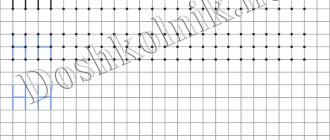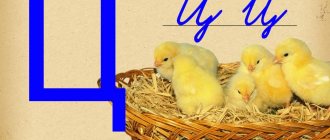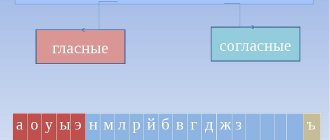Purpose of the lesson: we study the letter G, the formation of reading skills, the development of speech skills, the improvement of phonemic awareness, the basics of elementary graphic skills.
Tasks:
- introduce the preschooler to the letter G and the correct pronunciation of the sound;
- teach how to write the printed letter G in squares;
- to generate interest in learning poems and riddles.
Name what is shown in the pictures below:
Geese
Pear
Mushrooms
Peas
- Tell me, how do geese scream?
- HA - what is the first sound here?
- What is the first sound in the word geese?
- What sound is there in both the word pear and the word carriage?
- Is the sound [G] in the word Pear at the beginning, at the end or in the middle of the word? - Railway carriage? - Thunder? - Horns?
When we pronounce the sound [G], the back of the tongue hits the palate deep in the mouth, and the tip of the tongue hits behind the lower teeth. Say: G! The back of the tongue hits the palate and prevents air from freely leaving the mouth when we pronounce the sound [G].
- Vowel or consonant sound [G]?
- Voiced or voiceless?
- Why?
Assignment: printed letter G for preschoolers
Write the letter G in the air. Draw a vertical stick, add a horizontal stick on top.
Draw the sticks carefully along the cells with a simple pencil or ballpoint pen.
In cases where the child is asked to write a whole line of a letter, syllable or word, the adult gives a writing sample at the beginning of the line. If a preschooler has difficulties, then an adult can draw two approximate lines, or put reference points that the child will connect with lines, or write the entire letters, and the child will simply circle them in a different color. Calligraphy should not be required at this stage of training.
Print
Articulation of the sound G
When pronouncing the sound G, the vocal cords work. Without their vibration, sound will not be created in the correct way.
The ligaments, in the process of trembling, transmit the air flow located in the larynx.
G itself is a back-lingual (laryngeal), explosive.
Air breaks through the tight seal between the back of the tongue and the soft palate and a noise occurs.
The pronunciation of the sound in the endings -ogo, -ego is very peculiar. We hear and pronounce the sound G here as [v] - beautiful (as we write) - beautiful [v]o (as we say).
A very common sound of G in words such as “aha, uh-huh” in the form of the Ukrainian guttural G.
Continue the sentence
I want to become a strongman. I come to the strongman: - Tell me about this - How did you become a strongman? He smiled back: “Very simple.” For many years, every day, getting out of bed, I lift... (dumbbells). The blackest of all migratory birds, Cleans the arable land from worms, Jumps across the arable land all day long, And the bird is called... (rook).
Mikhail played football and scored into the goal... (goal).
I am very proud that I am not a duck, but... (a goose). Boats are sailing on the sea, People are using oars... (rowing).
I respect water very much in any bad weather. I keep away from dirt - Clean gray... (goose).
The buds on the willow burst with a crash. On the river the ice cracks in the night. And they build nests without delay. The first ones on the branches are... (rooks).
It dried out in the hot sun and bursts out of the pods... (peas).
Goals and objectives
Goals:
- learning the letter N with children;
- develop oral and written speech;
- improving phonemic hearing - identifying and analyzing sounds;
- learning educational texts;
- We form hand motor skills.
Lesson objectives:
- learn to recognize, correctly pronounce, and write the letter N;
- through solving riddles, gain analysis and logic skills, increase interest in learning new material;
- through poems, train the child’s memory, influence the emergence of new neural connections in the brain.
Tale about the letter G
General Gena Little Goose Gena dreamed of becoming a general. One day, when he was left alone at home, he opened his wardrobe, put on his father’s tie and galoshes, put a huge newspaper hat on his head, and put a large nail under his wing instead of a saber. I looked in the mirror - he turned out to be a real general! Gena walked out into the yard with a proud gait, and there the little jackdaws were playing little towns. - Hey, little jackdaws! Look what kind of general came to you! And the little jackdaws start shouting: “Are you the general?” Where's your saber? “But here, under the wing,” says Gena. - We thought it was your thermometer! You are not a general, just a goose in a newspaper hat. “Oh, you stupid ones,” Gena said sadly. - You have no imagination. (G. Yudin)
Notes “Sound and letter B” outline of a literacy lesson (senior group) on the topic
Lesson summary “Sounds (B – Bb), letter B.”
Goal : familiarization with the sounds B and B, the letter B.
Tasks:
1) Learn to characterize sounds; develop phonemic awareness skills; consolidate the ability to find the place of sound in a word.
2) Develop thinking, voluntary attention, phonemic processes; facial muscles, fine and gross motor skills.
3) Create a good mood, cultivate neatness, kindness, mutual assistance; desire and ability to work in a team, encourage activity and independence.
Equipment: signal cards (blue, green), cut cards “Place of sound in a word”, subject pictures for the sound being studied, “miracle tree”, daisies for differentiating sounds, cards for the prevention of dysarthria, a letter from a kindergarten graduate.
Riddles for children starting with the letter G
Without a command they get into formation and go to the pond. Who walks in a long chain, Who loves discipline so much? (Goose with goslings) Long neck, red paws, Nipping at the heels, run without looking back. (Goose)
The box dances on its knees - Sometimes it sings, sometimes it cries bitterly. (Harmonic)
Hairy, green, she hides in the leaves. Even though he has many legs, he still cannot run. (Caterpillar)
She made some noise, made some noise, washed everything and left. And I watered the gardens and vegetable gardens of the entire area. (Storm)
Four blue suns in grandma's kitchen. Four blue suns burned and went out. The shea is ripe, the pancakes are sizzling, the sun is not needed until tomorrow. (Gas stove)
Here is a horse rushing across the sky - Fire is flying from under his feet. The horse hits with a mighty hoof and splits the clouds. He runs so hard that the earth below trembles. (Thunder)
He is a rocking chair and a bed, It’s good to lie on him. He is in the garden or in the forest, swinging in the air. (Hammock)
The small, remote one passed through the earth and found Little Red Riding Hood. (Boletus mushroom)
Without hands, without an axe, the hut was built. (Nest)
What a fruit! A box with a secret! The seeds look like glass, all transparent, all pink. If you shake it, how strange it is, it doesn’t ring. (Garnet) A sheet of paper is brought to our apartment in the morning. On one such sheet there is a lot of different news. (Newspaper)
They hit Yermilka on the back of the head. He doesn't cry, he just hides his nose. (Nail)
He wanders importantly through the meadow, comes out of the water dry, wears red shoes. Gives soft featherbeds. (Goose)
Under the pine tree by the path Who is standing among the grass? There is a leg, but no boots, There is a hat, but there is no head. (Mushroom)
There is a commotion in the yard: peas are falling from the sky. Nina ate six peas and now has a sore throat. (hail)
I’ll sit under your arm and tell you what to do: Either I’ll let you go for a walk, or I’ll put you to bed. (Thermometer)
I am entirely made of iron, I have neither legs nor arms. I can fit up to my hat into the board, and for me everything is knocking and knocking. (Nail)
Sharp fingers stand in one row - Scratchy fingers: Pick up armfuls. (Rake)
Two brothers live across the road, but they don’t see each other. (Eyes)
How to teach your child the alphabet using creativity
Parents will be interested to know that in addition to the classic methods of learning about letters, there are other exciting methods that will interest both adults and children. They are based on creative activities, which always attract preschool children: appliqué, drawing, modeling, design.
Application
An adult and a child cut out letters from thick paper of a fairly large size. Then comes the preparation of decorations, this can be cereals, fabric, colored paper, beads. Decorations are applied to stencils using glue. The result is bright, beautiful letters that can be assembled into a garland and placed in different places (children's corner, wall, on the Christmas tree).
Drawing
Drawing letters is an original technique for memorizing them. You can draw on paper with felt-tip pens, on a board and asphalt with crayons, or with a stick on the sand. For the same purpose, you can use all kinds of coloring books, old magazines, in which you can search with your preschooler and trace familiar letters with a felt-tip pen.
Modeling
Letters will be remembered faster if you hold them in your hands and manipulate them, that is, sculpt them. At the same time, it is a good tool for the development of fine motor skills directly related to speech. Plasticine, clay, and salt dough are suitable for this purpose. Just like in applique, finished letters can be decorated with polka dots, beads, or simply painted with gouache paints.
Construction
Building letters is a fun activity for kids! It helps not only to consolidate the alphabet, but also develops hand motor skills, thinking, attention, and the desire for associations (seeing letters in surrounding objects). You can build or design letters not only from a special construction set (metal, wood, plastic), but also from any available material material. For example, from sticks, matchboxes, little hardcover books. Everything your imagination is rich in can become material for constructing letters.
Dear parents! In modern pedagogy there are many original methods with which you can quickly learn letters and move on to reading. Every parent can teach their child letters. However, every parent must remember that learning should bring joy to the child, a living desire to learn new things, and not be a tedious, monotonous task. Your meaningful decision, patience, and love for your child will help you achieve good results. Good luck with raising your children!
Funny poems about the letter G for children
Say it louder The word “thunder” - The word rumbles like thunder. (A. Barto) Along a narrow path, with goose steps, the goose army marches in single file. (A. Sanin)
Here are geese with a brood of goslings, making noise and hissing like snakes. They threaten the truck, craning their necks. But the truck is not afraid of a flock of loud-mouthed geese. He threatens the gander with a horn, clearing the road. (S. Marshak)
Jackdaw sat on the fence, Rook started a conversation with her. (B. Timofeev)
The goslings by the water are cackling and singing. The Goose can’t stop looking at the goslings. He can't stop looking at it, he's proud of the goslings: - Ha-ha! These goslings are the loudest of all in the world! (V. Lunin)
Goose bought himself an accordion, but it was a little holey. The harmonica sang well and hissed like a goose. A puppy was walking down the street - either Fluff or Buddy. I walked in the snowstorm and the sun, and walked in the rain, and even if it was snowing, a puppy walked down the street. I walked in the heat, in the cold and in the damp. Walked, walked, walked and grew up. (V. Levin) Hungry, cold, Jackdaws, sparrows! Hungry, pigeons - my little ones! Come and visit us, we have a handful full. Peck, visit, Don’t be afraid, peck! Gurg-gul-gul! (E. Blaginina)
Rook was swinging in a hammock. Geese are in the waves on the river. Pigeons flew past and sat down on a twig. The twig sways - It’s not bad. (A. Pudval)
Sad clown - Hippopotamus With a sad voice Sings a sad song - Very sad: - I love the frog Delicious. (G. Satir)
Recommendations for getting to know the alphabet
To make learning about letters an interesting and accessible activity for preschool children and encourage them to further learn to read, parents need to get acquainted with the recommendations of specialists. This will make it possible to easily organize home classes. So, what are the principles by which we teach letters with children:
- Play, the leading activity in preschool age, should become the main method of teaching children, so the principle of homework is to learn letters by playing.
- Getting to know the alphabet is quite a difficult task for preschool children, so the work is carried out gradually, from simple to complex. There is no need to require your child to mechanically memorize the entire alphabet at once. At each lesson, you need to meaningfully practice one letter, consolidate previous material and master new ones.
- Before starting training, an adult must learn to correctly name letters: clearly and stressed consonants (b, but not “be”, m, r, s, but not “em, er, es”). The child must be taught to pronounce vowels in a drawn-out manner, for example, a - a-a.
- It is more useful to study sounds and letters at the same time to develop further syllable reading skills. This technique will help maintain interest in rather monotonous tasks. You can begin to compose syllables when the necessary supply of letters appears (ba, ma, pa, yes). It is also necessary to show that the letter being studied is necessarily included in some words, for example, a - watermelon, o - autumn, y - snail, etc.
- Experts recommend introducing letters and sounds in the order in which they are formed in ontogenesis (individual development of the body). First of all, these are the vowel sounds a, o, u, s, e and consonants. The vowels i, e, ё, yu consist of two sounds, so they are learned at an older age.
- Consolidating knowledge about letters should be accompanied by activities that are interesting for the child: drawing, modeling, appliqué, design. For this purpose, experts have developed many games and exercises that can be used in preparation for homework.






